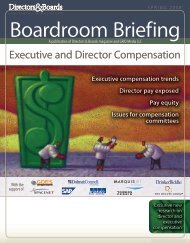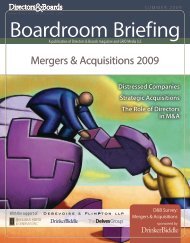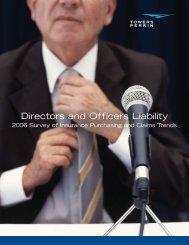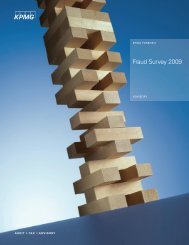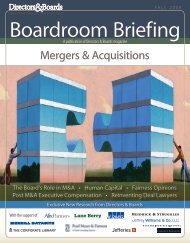The LRN ethics and compliance risk management practices report
The LRN ethics and compliance risk management practices report
The LRN ethics and compliance risk management practices report
You also want an ePaper? Increase the reach of your titles
YUMPU automatically turns print PDFs into web optimized ePapers that Google loves.
Avoiding the<br />
Pitfalls of<br />
Detection<br />
An Interview with Marjorie Doyle,<br />
Global Practice Leader, Ethics <strong>and</strong> Compliance<br />
Solutions, <strong>LRN</strong><br />
Marjorie Doyle has extensive expertise in building<br />
sound detection programs <strong>and</strong> avoiding the pitfalls<br />
that plague many organizations. She notes that “not<br />
enough resources” is a perennial challenge in <strong>ethics</strong> <strong>and</strong><br />
<strong>compliance</strong>, but companies cannot rely solely on having<br />
an anonymous hotline <strong>and</strong> wait for the calls to come<br />
in. “Companies need to have a wide range of tools to<br />
implement robust <strong>and</strong> effective detection procedures,<br />
she says. “Most programs run out of resources by the<br />
time they get to auditing <strong>and</strong> monitoring, <strong>and</strong> they put<br />
their faith on having a hotline, without having thought<br />
about how to get people to use it.” As EVP <strong>and</strong> Chief<br />
Compliance Officer at Vetco, <strong>and</strong> Chief Compliance<br />
Officer at DuPont, she found that a company’s culture<br />
has a lot to do with whether employees will trust the<br />
hotline <strong>and</strong> be willing to use it. Companies need to be<br />
completely transparent, explaining in clear terms how<br />
<strong>report</strong>ing channels work, when employees should call,<br />
<strong>and</strong> what are the ramifications of <strong>report</strong>ing violations. In<br />
addition, Marjorie offers the following counsels:<br />
Look Ahead, Not Back: Too many <strong>risk</strong> assessment<br />
processes focus on past problems rather than on<br />
business strategies going forward. Some areas that<br />
require the most diligent detection simply don’t exist at<br />
the current moment, but will appear once the company<br />
enters a new market, completes a merger or moves<br />
a half-dozen back-office processes to an offshore<br />
outsourcing provider. Effective <strong>ethics</strong> <strong>and</strong> <strong>compliance</strong> <strong>risk</strong><br />
<strong>management</strong> <strong>and</strong> detection procedures need to look as<br />
much forward as backward.<br />
Pay Attention to the Middle: Studies have shown<br />
that when most people are faced with an <strong>ethics</strong> or<br />
<strong>compliance</strong> decision, they consider three things, in<br />
this order: 1) how their immediate boss is behaving;<br />
2) how their colleagues behave; <strong>and</strong> 3) their own<br />
moral compass. This places the largest responsibility<br />
on front-line supervisors, who need to recognize their<br />
role in effective detection. As a result, legal <strong>and</strong> <strong>ethics</strong><br />
<strong>and</strong> <strong>compliance</strong> professionals need to effectively<br />
communicate with these supervisors. You have to win<br />
their hearts <strong>and</strong> minds to convince them that <strong>ethics</strong><br />
DISCUSSION<br />
<strong>The</strong> keys to improving detection as companies mature their <strong>ethics</strong> <strong>and</strong> <strong>compliance</strong> programs<br />
require a dual-pronged effort. One prong must focus on clearer communications with<br />
employees about what, why, how <strong>and</strong> when to <strong>report</strong>, <strong>and</strong> the other prong is, yet again,<br />
to instill trust in employees that the company’s culture is based on self-governance, which<br />
means everyone must assume a role in watching over the ethical health of the firm. No<br />
one can be immune from taking responsibility to <strong>report</strong> violations. Clearly, to achieve this<br />
buy-in, companies must look inward <strong>and</strong> have honest discussions to fashion fair policies<br />
about <strong>report</strong>ing. If they are going to have zero tolerance for infractions, they must have zero<br />
tolerance for retaliations. Mutual trust will drive detection.<br />
Respond<br />
If detecting violations is the chink in the armor of <strong>ethics</strong> <strong>and</strong> <strong>compliance</strong>, investigating<br />
violations is the shield. Given that companies have had to investigate <strong>ethics</strong> <strong>and</strong> <strong>compliance</strong><br />
problems for many years, they have built up the expertise to h<strong>and</strong>le them correctly. Good<br />
investigation procedures are being followed in many companies: e.g., involving many<br />
functions, from legal to HR to Ethics & Compliance, <strong>and</strong> alternating the leadership of the<br />
investigation as necessary depending on the nature of the violation. 30% of companies<br />
<strong>report</strong> having no significant challenges in investigating violations. This is one area where<br />
team efforts clearly have a positive impact on success.<br />
Can responding to violations be improved further <strong>The</strong> keys appear to be in better training<br />
for investigators <strong>and</strong> hiring more of them. <strong>The</strong>se two factors are tied in with the leading<br />
challenge: not enough resources, cited by nearly 1/3 of respondents. It is likely that when<br />
companies provide a greater commitment to an ethical culture, they will experience fewer<br />
violations, <strong>and</strong> resource savings can be made in responding activities. In short, a values-based<br />
culture <strong>and</strong> self-governance will yield savings that can be applied elsewhere.<br />
Evaluate<br />
When it comes to evaluating <strong>ethics</strong> <strong>and</strong> <strong>compliance</strong> efforts, companies must underst<strong>and</strong><br />
how successful their programs are in mitigating <strong>risk</strong>s, reducing ethical breaches, improving<br />
employee conduct, <strong>and</strong> increasingly, in analyzing performance improvements that their<br />
programs contribute towards the company’s bottom line. Companies need to periodically<br />
measure how their programs are faring in their workplaces. <strong>The</strong>se evaluations may be<br />
quantitative or qualitative, or both, depending on each company’s needs. <strong>The</strong> findings<br />
from evaluations are most valuable when they are used to improve the programs being<br />
offered, thus increasing underst<strong>and</strong>ing <strong>and</strong> establishing clear linkages between <strong>ethics</strong> <strong>and</strong><br />
<strong>compliance</strong> programs <strong>and</strong> their improved business results. A key best practice is to share<br />
the evaluation results with the Board <strong>and</strong> senior leadership, ensuring that they stay in<br />
touch with the program’s results <strong>and</strong>, by extension, its value to the company. This should<br />
assist in reinforcing their support for the program, which then cascades back through their<br />
communications to employees that the company is making progress. In effect, evaluations<br />
are the corollary to <strong>risk</strong> assessments, bringing the cycle of activities full circle, demonstrating<br />
a return on investment.<br />
<strong>The</strong> 2008 survey indicates that nearly three-quarters of companies are making efforts at<br />
using evaluations to improve their programs. More companies perform annual evaluations<br />
than quarterly ones, but the frequency depends entirely on each company’s needs. On the<br />
downside, only 6 in 10 companies share the findings with their board, <strong>and</strong> almost 1 in 3<br />
companies lack resources to conduct evaluations. Also down are the uses of qualitative <strong>and</strong><br />
quantitative measures. Such results might indicate that some companies are not yet mature<br />
in their evaluation processes, <strong>and</strong> they will need to invest more to master this phase of the<br />
<strong>ethics</strong> <strong>and</strong> <strong>compliance</strong> process.<br />
<strong>LRN</strong> | 2008 Ethics <strong>and</strong> Compliance Risk Management Practices Report | 21





![[link to PDF] for a copy of the briefing paper - Directors & Boards](https://img.yumpu.com/43729022/1/190x245/link-to-pdf-for-a-copy-of-the-briefing-paper-directors-boards.jpg?quality=85)

